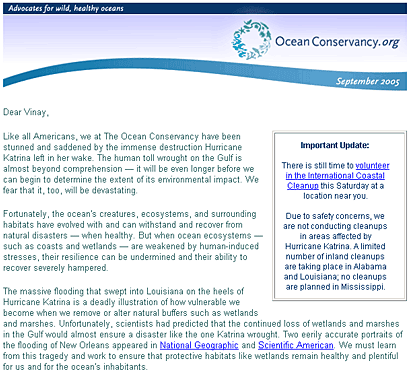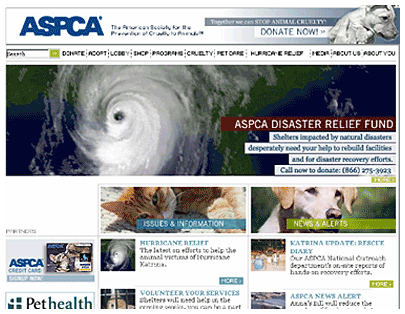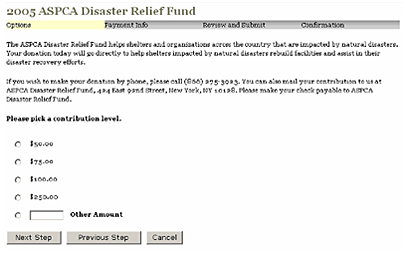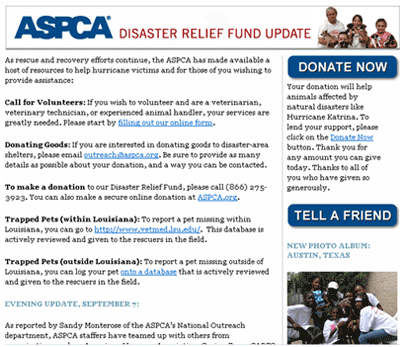|
Nov/Dec 2005 Fundraising After Natural Disasters and Crises: Internet Strategies for Non-Relief Nonprofitsby Vinay Bhagat, Founder and Chief Strategy Officer, Convio
However, empirical data suggests that, in aggregate, non-relief nonprofits do not suffer prolonged negative fundraising impacts following major disasters. According to research by the Target Analysis Group, the Southeast Asia tsunami actually may have stimulated philanthropy for these types of organizations.
Similarly, the 9/11 terrorist attacks alone did not seem to cause a significant drop in giving to non-relief charities. Target Analysis Group's evaluation of actual giving histories from 22 national fundraising organizations indicates that the economy played a greater role in the overall fundraising performance of these groups than the events of 9/11 or the subsequent postal delivery issues due to Anthrax scares.
Given this data, when a disaster hits, non-relief organizations should take a measured — versus crisis-oriented — communications approach. Consider the following three approaches. Approach one: Continue to communicate and link your missionAfter a respectful pause, continue mission-related email communications. Start by acknowledging the disaster and the need to fund relief efforts. If appropriate, an organization should find linkages between its mission and work with the relief efforts to make these communications salient. The Ocean Conservancy's email, sent approximately two weeks after Katrina, is a great illustration.
Approach two: Conduct a micro-campaignAn organization involved in supporting relief efforts (even though it is not a relief agency per se) should adopt a proactive fundraising strategy using the online "micro-campaign" technique. A micro-campaign is a context-specific fundraising effort for which a group:
After Hurricane Katrina, a number of nonprofits that promote animal welfare, including the American Society for the Prevention of Cruelty to Animals (ASPCA), American Humane Association and the SPCA of Texas — all involved in Katrina-related animal welfare operations — conducted substantial online "micro-campaigns," raising millions of dollars in days.
Approach three: Be a fundraising agent for relief effortsA nonprofit can act as a fundraising agent for relief efforts, tapping its own constituency. American Diabetes Association (ADA), American Cancer Society and the American Heart Association jointly contributed $1 million to the Bush-Clinton Katrina Fund. ADA also launched an online appeal to its constituency. While a non-relief nonprofit may fear that gifts solicited for a disaster group will detract from its core fundraising programs, more likely is a lift in participation rates among prospects on file. In addition to providing urgently needed aid in the wake of a disaster, this tactic reinforces an important message to the non-relief nonprofit's constituency — that it is a responsible organization.
SummaryAfter a disaster, a non-relief agency can use the Internet as a timely and cost-effective method for communicating with its constituency, relationship building and fundraising. An organization that is not directly involved in relief efforts should be measured, versus crisis-oriented, in its online communications. After a respectful period, communicate anew with constituents and, if appropriate, show saliency to the disaster relief efforts. A non-relief group directly supporting relief work associated with its mission should adopt a proactive online fundraising approach. Have a colleague who might be interested in this topic? Why not forward this article? |
|

 When a major disaster occurs such as Hurricane Katrina, the December 2004 Southeast Asia tsunami or the 9/11 terrorist attacks, donors appropriately give generously to relief efforts. Meanwhile, in the aftermath, many nonprofits focused on non-disaster missions often are concerned about the potential adverse impact on their fundraising. They worry that donors will send their charitable dollars to disaster relief groups leaving little, if any, money for their organizations. They grapple with how best to communicate with constituents to drive giving while being sensitive to the important needs and work of relief organizations.
When a major disaster occurs such as Hurricane Katrina, the December 2004 Southeast Asia tsunami or the 9/11 terrorist attacks, donors appropriately give generously to relief efforts. Meanwhile, in the aftermath, many nonprofits focused on non-disaster missions often are concerned about the potential adverse impact on their fundraising. They worry that donors will send their charitable dollars to disaster relief groups leaving little, if any, money for their organizations. They grapple with how best to communicate with constituents to drive giving while being sensitive to the important needs and work of relief organizations. 




